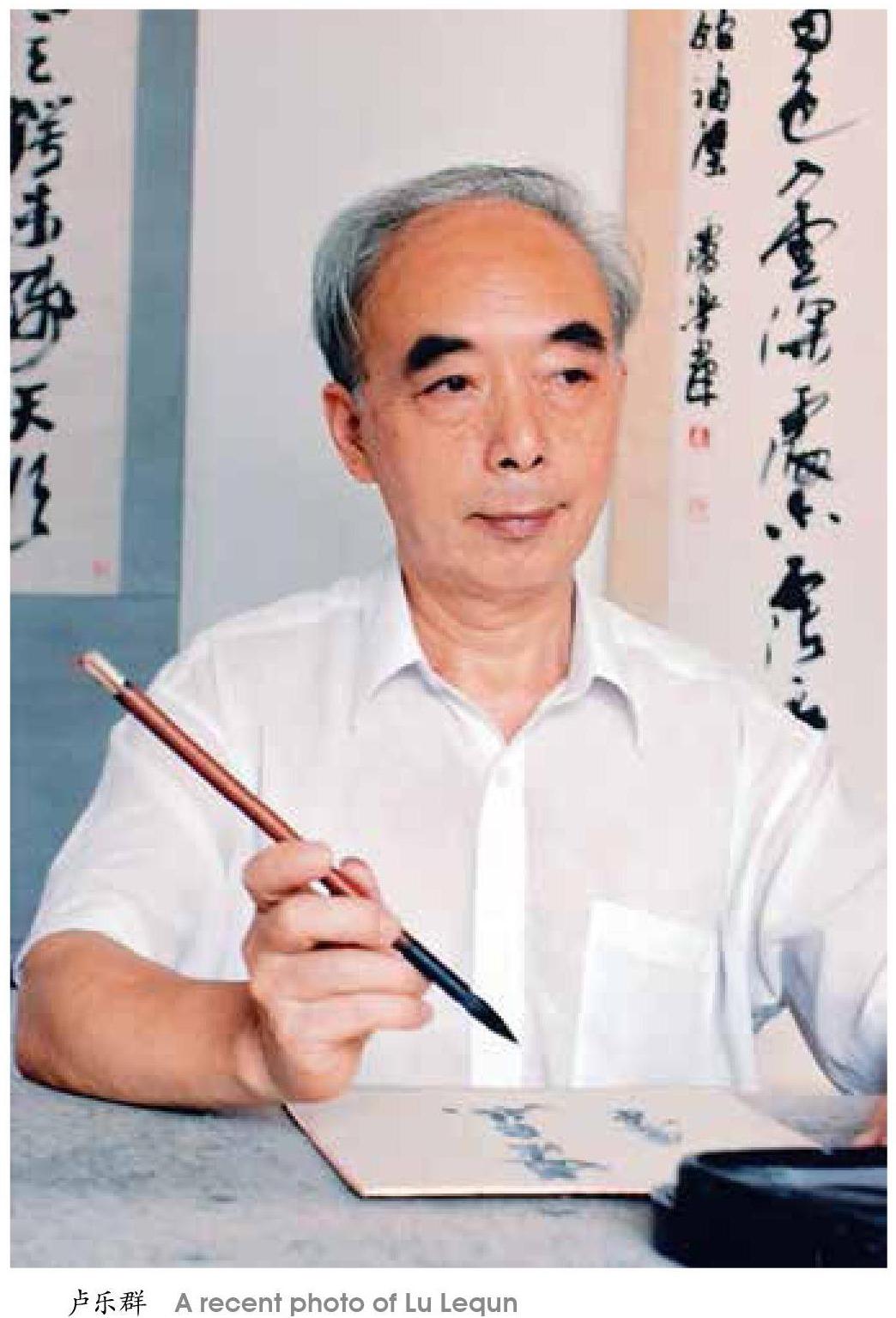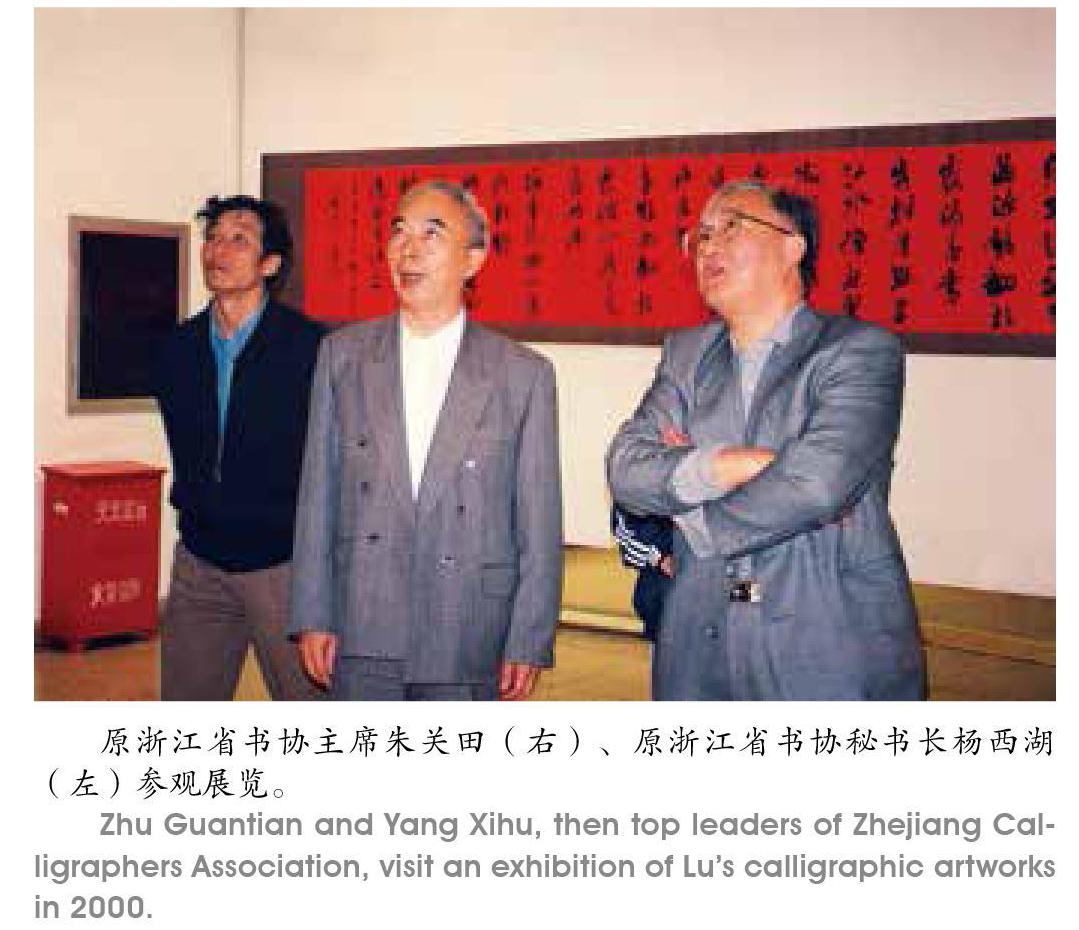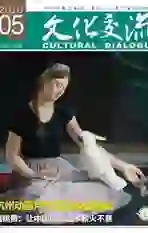卢乐群:静水流深注笔墨
2018-05-09朱晓峰卢云芬
朱晓峰?卢云芬
明末张岱曾说:“人无癖不可与交,以其无深情也;人无痴不可与交,以其无真气也。”癖,可以理解为一种根深蒂固的信念,一种超越于凡俗的坚执,一种沉潜中的追寻。沉潜内修,沉潜创新,必须舍弃现实种种诱惑,才有可能体悟到艺术的真谛,修得正果。卢乐群先生的书法,正是其耐得住寂寞,几十年如一日孜孜以求,才达到蓄深养厚的艺术高度。
卢乐群,1942年生,浙江临海人。书法受业于沙孟海、陆维钊诸先生。书法作品曾获全国群众首届书法比赛二等奖、全国四届书展二等奖、全国五届书展全国奖、全国三届中青展一等奖、国际赛克勒杯一等奖,曾被书坛誉为“获奖专业户”。近年来他相继在北京中国美术馆、日本东京《朝日新闻》会馆、新加坡书法中心等地举办个人书法展,饮誉海内外。出版有作品集2册,发表《民间书法的启迪》等多篇论文;历任浙江省书法家协会副主席、中国书协创作委员会委员、台州市文联主席、台州学院客座教授等职。
卢乐群的书作因既具有历史的、古典的韵味,又富含着强烈的时代创新色彩而为世人所重。
一个人的成长或多或少都会受到地域的影响,千年古城临海的灵山秀水滋养了他温和而坚韧的性情,亦柔亦坚的地域基因深深潜藏在他的血液之中。卢乐群家学渊源,其祖父曾在杭州图书馆工作,1949年后回到临海。祖父擅长书法,卢乐群幼年即在祖父指导下临习历代名家字帖,打下扎实的功底。卢乐群一往情深回忆起祖父当年手把手教自己习书的情景:记得有一次,我突发奇想,打破常规,断开相连的笔划,造成似断非断的视觉效果,受到祖父的夸奖。祖父常常用“头碗菜”来比喻习书的重要性,而童年的我也深深悟到这个道理。在一起习书的小伙伴中,我是最用功的一个,小小年纪手上就有了把笔痕,这让我很是骄傲。尽管有时也会调皮偷懒,但内心还是深爱书法的。卢乐群至今记得祖父有一个半新不旧的皮箱,里面有其珍爱的书籍、字画,有沈尹默、徐悲鸿等大家的作品,也有父亲留下的精美书法作品。儿时的卢先生总是对那个宝箱充满想象。
回忆起父亲,卢乐群神情凝重。父亲爱好书法,写得一手好字,而且与于右任、沈尹默等书家交情深厚。后来父亲去了台湾,卢乐群的青少年时代为此受到牵累。卢乐群做过临时工,卖过柴,拉过车,拌过水泥。他给自己起了个笔名:卢樵。
“文革”十年中,卢乐群一家受到冲击,收藏的书籍、字画被毁,找工作受到歧视。他也曾迷茫、彷徨,但他心中有一股不向命运低头的倔劲头,他对书法的探索没有停止。卢乐群暗暗对自己说:我要扼住命运的咽喉,等待转机。
卢乐群人生中几个重要的良师就是在这段岁月中结识的。沈敦五先生是宁波师专校长,此时已退休在家,他的文学素养极高,尤擅诗词。许良奇先生是中学语文教师,也有很厚的文学功底。乡贤朱在勤先生对于书史与理论研究颇深,不仅传授知识,还教给学生许多为人处世的道理。他们对艺术的执着和朴素的人生观、艺术观深深影响了这个年轻人。
经朱在勤先生指点,卢乐群决定去杭州拜谒沙孟海先生。
1972年秋,卢乐群怀揣梦想来到杭州,找到了龙游路12号沙孟海先生的家。站在写满历史痕迹的屋檐下,年轻人犹豫片刻,然后鼓起勇气敲门。一代宗师沙孟海开了门,脸上挂着询问的笑意。明白这个年轻人的拜师意图后,沙老绽放一脸笑容,伸出温暖的双手。
“在当今文化如此萧条的时期,你为什么还这么追求书法艺术?”沙孟海问道。
“这是祖父、父亲和我三代人的共同爱好。”卢乐群回答。
“吾道不孤。”沙老感慨道。
沙老看过年轻人的习作,欣然收下这个徒弟。令卢乐群至今难忘的是,沙老嗓门响亮,知识面宽,文化学养极高。其间,沙师母不断插话问讯故乡,因为她也是台州人,这使卢乐群备感亲切。老师灌顶良言溢满学生心房。从老师家出来已是傍晚,学生的心充盈浓浓的欢愉和幸福。此时,漫过心际的是春风般的暖意,抬眼远眺,蓝天深邃高远,晚霞安静祥和,还有一行大雁在天空飞翔。
翌日下午,卢乐群再次来到沙老家,请教大师。“看沙老写字,运笔大开大合,势如横扫千军,令人叹为观止。”后来,经沙老介绍,他又认识了陆维钊先生。就在陆先生家,他与书法名家朱关田相识,后来还成为至交。
有幸得到沙老的悉心指导,卢乐群如逢甘露,茅塞顿开。他凭藉雄厚的文学功底,躬身求索,广泛涉猎艺术精髓。从书法概论、汉字的创造与书法的产生,从字体结构、章法布局等方面,他用一种饥渴的眼光细细打量,不停研习、思考、领悟,全身心地投入到一種超脱的境界之中,沉浸在翰墨字香中。
佛教对中国的书法艺术产生了巨大的影响,与书法艺术在思维方式、情感体验等各方面是相通的,而佛教的精神内涵也不同程度上渗入了中国书法艺术。从骨子里来说,卢乐群是一个深受传统文化影响的文人,但和“居庙堂之高则忧其民,处江湖之远则忧其君”的儒家不同,他追求的是一种自在、自得、适意、畅达的艺术境界。卢乐群年少时便对佛教产生了浓厚的兴趣。禅宗空的境界,王维、陶渊明等诗人饱含寂静空旷之感的诗景契合了卢乐群的心境。“结庐在人境,而无车马喧。问君何能尔?心远地自偏。”
有了高妙的领悟能力,卢乐群自然而然进入一个崭新的艺术天地。虚静恬淡游于艺,澄怀观道写人生。他把自己的个性、气质、情思渗入创作之中,与笔墨交融,静静地守着自己心中的精神家园。卢乐群是走碑帖交融书法之路的第三代书家中的杰出代表。
卢乐群身兼书法家与企业家两个身份。无论工作多忙,他必定保证每天5小时以上习书,揣其精髓,悟其真谛。对于卢乐群,做企业更多的是一种承担责任,作为领头羊,必须对员工负责,而且要负责到底。
一份責任,让卢乐群成为合格的企业家;一种使命,成就了一位书法大家。
Calligrapher Lu Lequn, born in 1942, is a man who was portrayed and discussed by Zhang Dai (1597-1689), a poet and essayist of the Ming Dynasty (1368-1644). Zhang said “dont befriend a person who doesnt have a hobby, because having no hobby means having no dedication; dont befriend a person who doesnt have any obsession, because having no obsession means having no real understanding of life”. For Lu, dedication and obsession is exactly what has driven him to explore the secret and beauty of calligraphy for all these decades.
Lu Lequn stands out as a calligrapher because his art presents the elements of classical times and the innovative touches of today. Part of his dedication and obsession came from his family. His grandfather worked in Hangzhou Library before 1949. After the liberation, he came back to Linhai, their hometown and a region in the southeast of Zhejiang Province. Lu Lequn studied calligraphy under his grandfathers guidance. In the early years, he copied the masterpieces of ancient calligraphers. Of all the children who were learning calligraphy together with him, the young boy worked hardest. He was proud of the marks in his hand left by holding a brush-pen year in year out. One day, he impulsively wrote some broken brushstrokes, which were supposed to be connected. The result looked fresh and innovative. The grandfather was happy with this unexpected development and praised the boy. Lu Lequn remembers a leather suitcase that his grandfather had. It was a treasure box full of books and artworks of calligraphy and paintings by some modern masters. Also in the suitcase were some calligraphic pieces written by his father.
His father was an ardent calligrapher and was friends with Yu Youren and Shen Yimo. The fathers move to Taiwan caused a lot of trouble to Lu Lequn. In the chaotic years of the Cultural Revolution (1966-1976), Lu and his family suffered because of his father. The familys art collection was destroyed and he had trouble finding a proper job. But his dedication to and obsession with calligraphy didnt die despite so much trouble.
He practiced calligraphy hard. It was during the tumultuous years that he came to know some tutors and guardians. He made friends with Shen Dunwu, a retired teacher specialized in poetry, Xu Liangqi, a middle school language teacher versed in literature, and Zhu Zaiqin, a calligrapher specialized in history and theory. Lu learned a lot from them. In particular, their worldviews and dedication and obsession left deep marks on the young calligrapher.



Zhu Zaiqin advised Lu Lequn to go to Hangzhou and visit Sha Menghai, the top calligrapher of Zhejiang Province. In the autumn of 1972, Lu visited Sha at his home at 12 Longyou Road. The master received the young man warmly. Asked why he was pursuing calligraphy in these years difficult for culture and art, Lu replied that it was a love shared by three generations in his family.
Through Sha, Lu Lequn visited Lu Weizhao and it was at Lu Weizhaos home that Lu Lequn met Zhu Guantian. Lu and Zhu became fast friends and the two calligraphers friendship has lasted.
It was under the guidance of Sha Menghai that Lu Lequn found his direction forward in calligraphy. He is now an exemplary representative of the third-generation calligraphers exploring a challenging style pioneered by Yu Youren and Sha Menghai and Lu Weizhao. These calligraphers saw a new path in integrating the calligraphy carved on stone steles in very ancient times and the calligraphy written on paper and other similar media. The fusion was once considered impossible and many failed. That is why the successful query is considered so rare.
Many factors have contributed to the successful fusion in the hands of Lu Lequn. Among so many contributing factors, he has worked hard. Now at 76, he still keeps practicing calligraphy five hours a day.
Though he talked indirectly about persons like Lu Lequn centuries ago, Zhang Dai of the Ming Dynasty never really knew how far a person like Lu could travel in his pursuit through dedication and obsession. Lu has traveled far down the path opened up and explored first by his predecessors in the 20th century.
